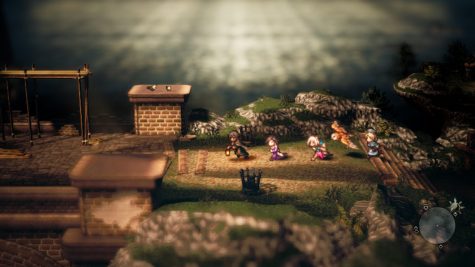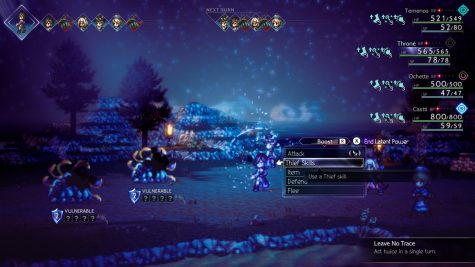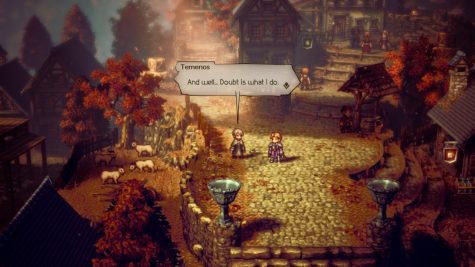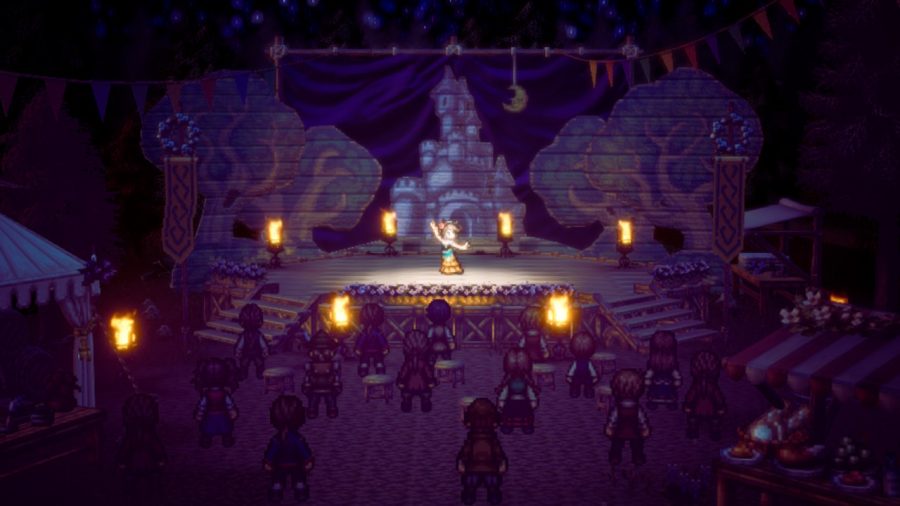One of 2018’s most standout games was “Octopath Traveler,” a faithful callback to classic turn-based RPGs such as “Final Fantasy” or “Dragon Quest” that introduced the “HD-2D” art style. Five years later, the game now has a sequel, and although “Octopath Traveler II” does little to differentiate itself from its predecessor, it still manages to build upon the formula, leading to a more refined, more ambitious and overall funner experience.
Much like the first game, “Octopath Traveler II” is a 2-D turn-based RPG sporting the HD-2D art style, in which animated pixel sprites are set in more realistic and high-definition scenery and lighting. Combat revolves around the “break and boost” system which involves exploiting enemies’ weaknesses to “break” them and utilizing a battle currency to “boost” the strength of skills, the number of times an attack is used or the number of turns status changes last from your skills.
This sequel’s fundamental mechanics are still a blast to use and the many backgrounds both in and out of battle also look absolutely gorgeous and mesh well with the sprites. This time, however, the game features dynamic camera angles when characters use powerful skills or during cutscenes, which gives it a more grand and cinematic feel.

This time around there is a day-and-night cycle in which different non-player characters (NPCs) move their location or appear based on the time of day. The time of day also affects the enemies players encounter, with stronger enemies appearing at night. Players can either wait or manually switch between day and night with the tap of a button.
The game’s eight characters, each with their own individual storyline, can be tackled in any order. While the first game’s characters seemed a bit generic and fit with the typical archetypes of their respective professions, this time around the characterization took a completely different direction, at times completely subverting the trope.
For example, the Cleric Temenos is witty, has a sharp-sounding voice and is skeptical of everything, including the very church he serves. Traits like this make the characters far more interesting and likable.
Characters’ path actions can again be used to obtain items or information, temporarily recruit NPCs to summon in battle and access new areas. Each character has a different path action for each time of day.
Side quests once more rely entirely on path actions and take the form of puzzles spanning the entire world. These quests range from simple to difficult and are all extremely fun to solve. These puzzles include helping a grape farmer save his crops with information found on the other side of the continent and listening in on a trial taking place then bringing over an NPC to testify, to name a few.
Unlike the first game, where characters only differed through their base jobs, path actions and traits, “Octopath Traveler II” goes the extra mile to ensure that all characters play differently.

Each character has a unique ability known as a “Latent Power” which can be activated during a turn once a specific gauge is filled. Latent Powers include useful traits such as maximizing the character’s boost points (BP), acting twice per turn, changing the scope of abilities while changing their potency and granting the use of unique abilities. Meanwhile, “EX Skills” are character-exclusive skills that are unlocked by finding specific areas and completing the character’s story.
Yasunori Nishiki returns as the soundtrack’s composer, creating a selection of music that is bigger and grander than before.
With that said, a common complaint with the first game was that the individual characters’ stories were largely disconnected. While the sequel does have story chapters featuring two characters, their individual stories are still isolated.
Regardless, “Octopath Traveler II” introduces a number of quality-of-life changes that solve inconveniences found in the first game. For example, sub-jobs can still only be assigned to a limited number of characters at a time. However, now they can be changed around automatically by selecting the job for another character.
Another notable change is that travel banter between characters can be viewed again. Furthermore, banter missed due to a character not being in the party at the time is retroactively added in once the chapter is completed or when the character is recruited.
“Octopath Traveler II” is a spectacular sequel that stays true to its predecessor while expanding on what came before. Players who didn’t care for “Octopath Traveler” may not warm up to the sequel, nor will people who dislike classic turn-based RPGs. However, as someone who loved the first game, I highly recommend “Octopath Traveler II” to those who are interested.





